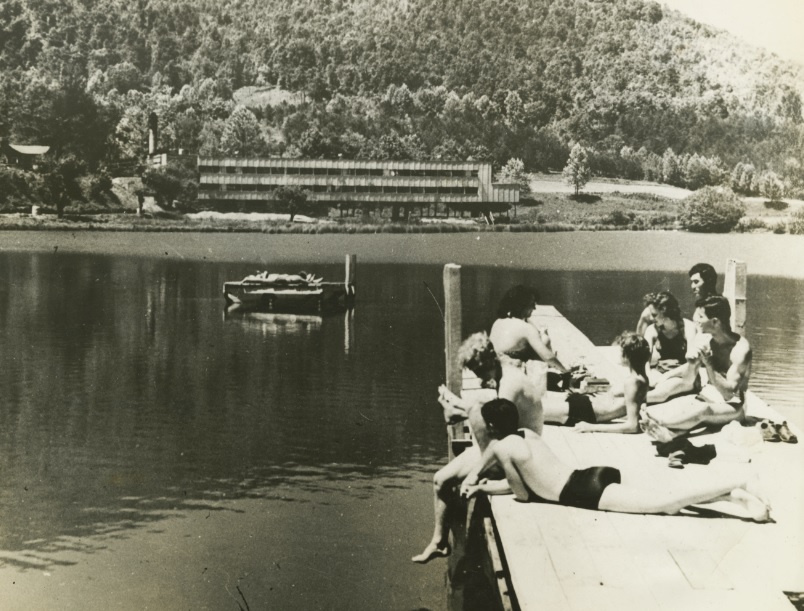‘Leap Before You Look: Black Mountain College, 1933–1957’

Leap Before You Look: Black Mountain College, 1933–1957
Institute of Contemporary Art, Boston
October 10, 2015 – January 24, 2016
Leap Before You Look: Black Mountain College 1933–1957, currently on view at the Institute of Contemporary Arts, Boston, features an elite and eclectic collection of works important to American and European modernism in the fields of art, film, dance, theater, music and literature. Curators Helen Molesworth and Ruth Erickson have succeeded in constructing a vivid testimony of the diverse artistic output that emerged from Black Mountain College, whose educational mission was born out of the vision of John Rice, a recently ousted college professor from Florida, who was inspired by American philosopher John Dewey’s views on education reform.
As the first comprehensive American exhibition to chronicle the history and impact of the College, the first gallery provides visitors with a useful chronology that outlines milestones from the school’s founding in North Carolina’s Blue Ridge Mountains, in 1933, until its closure in 1957. This same space also features one of only a few archival documents included in the exhibition in a glass case — a brochure published by the College in the 1940s entitled “Converting the Impossible into the Actual.” This text gives special insight into the promotional rhetoric of the program, classifying the College as an “educational adventure” and championing its self-sufficiency, collective work ethic, and commitment to individual creativity.
The remaining galleries are arranged into thematic, medium-specific, and stylistic categories that help to organize and balance two of the exhibition’s primary goals: a presentation of the school’s history and showcasing a vast multi-media survey of artists’ work created during their respective stays at the College. Praised for its progressive Socratic instruction and reformed liberal arts model, it is appropriate that three sections of the exhibition are devoted to the innovative and experimental spirit of College faculty, which included the German artists and Bauhaus émigrés Josef and Anni Albers, American architect Buckminster Fuller, and American poet Charles Olson. Additional thematic galleries, designated “Haptic,” “Scarcity and Modernity,” and “Modernisms,” address material and stylistic concerns, and although less focused than others, they nonetheless illustrate the range of ingenuity among College artists and their work produced at this time.

Visitors who are drawn to the captivating (and once lost) video projection of Merce Cunningham’s dance performance of “Changeling” (1957), should also take care not to miss John Cage’s Williams Mix (1952) playing nearby. The recording of nearly 600 distinct natural and man-made sounds, ranging from bull frogs to colliding metal, truly requires one to stop, listen, and discern the multiple strands of life that reverberate through the headphones. Similarly, at this point, when one is nearly halfway through the exhibition, visitors may choose to pause and reflect on the exhibition’s degree of success as more of a survey rather than critical appraisal.
Ultimately, the exhibition stays true to its title, by bringing to light the fearless nature that fueled this quiet reservoir of modernism. However, in recognizing the freedoms afforded by the College, which allowed for expanded creative boundaries, more could have been done to address the counter narratives unfolding outside of this artistic haven, which operated during a period of global uncertainty, turmoil, and transformation. For instance, although works like Emerson Woelffer’s Last Internment (1948) stylistically unite American and European modern aesthetics, as explained in the wall label, they also merit a deeper contextualization in light of World War II era internment camps, the costs of human conflict, and the lingering legacy of fear during the immediate postwar moment.
The tone of minimal political and social commentary seen throughout the exhibition is set early on as visitors enter. For example, the inclusion and placement of reproductions of New York Times headlines announcing key world events are positioned so high up on the wall, over the chronology in the first gallery, that their contextual value is relegated to almost unreachable and marginal heights. Attendees are also immediately greeted in the introductory gallery with an enlarged photograph depicting two young women walking through grassy fields along a meager dusty path in an uninhabited landscape, populated with only cabins and trees. Such amplified snapshots adorn walls and partitions throughout the exhibition providing candid glimpses of life at the College, and possess a certain anecdotal and visual appeal. However, the repeated prominence of these photographs looms large conceptually, and perhaps unintentionally, over-emphasizes the utopian atmosphere of the College.
With the school closing in 1957, what was its legacy in light of the turbulent decade that followed? What were the tensions that arose from the intergenerational conversations brought about by the collaborations between faculty and students, men and women, and a variety of races and ethnicities? How was the College as much a retreat, as it was a push forward creatively, and what did this retreat mean for those still living in a world that was plagued by the reality and aftermath of war? Ultimately, the ICA delivers an exhibition that is thoughtful in its conception and visual display, chronicling the College’s innovative educational doctrines and spirit of creativity. Yet, examining the legacy of Black Mountain College also means exploring the national and global legacy that this generation of intellectuals and artists inhabited, and perhaps the greatest contribution of this timely exhibition is the discourse that it inspires.
Elisa Germán
____________________
Leap Before You Look is on view at the ICA, Boston until January 24, 2016, and will then travel to the Hammer Museum in Los Angeles, California (February 21–May 14, 2016) and the Wexner Center for the Arts in Columbus, Ohio (September 17, 2016–January 1, 2017).